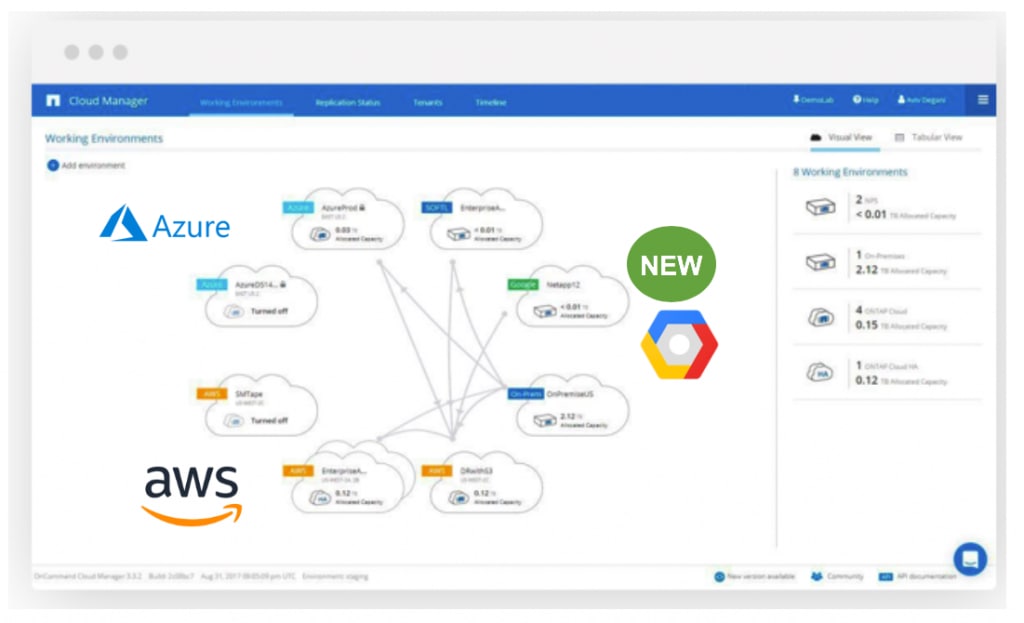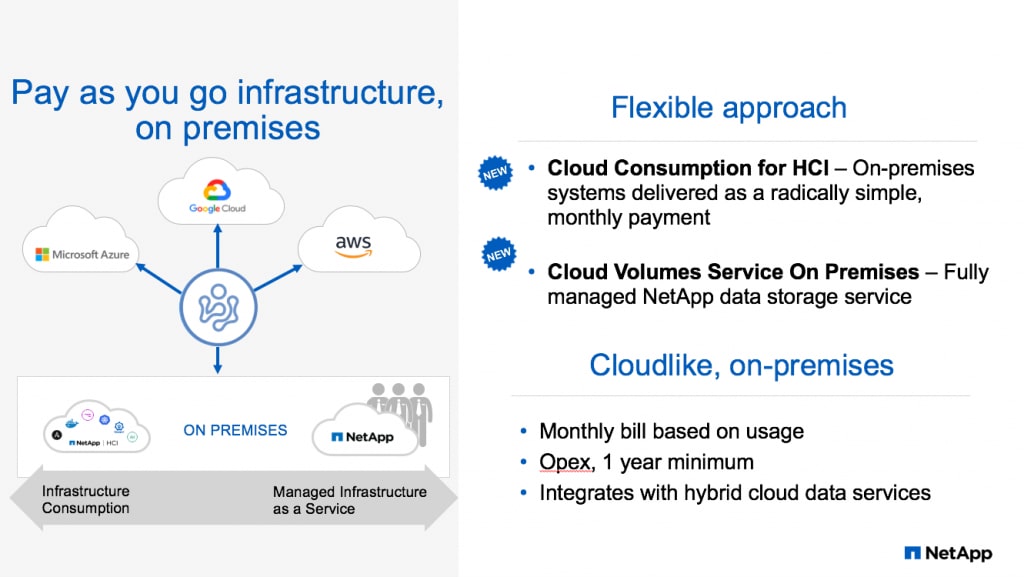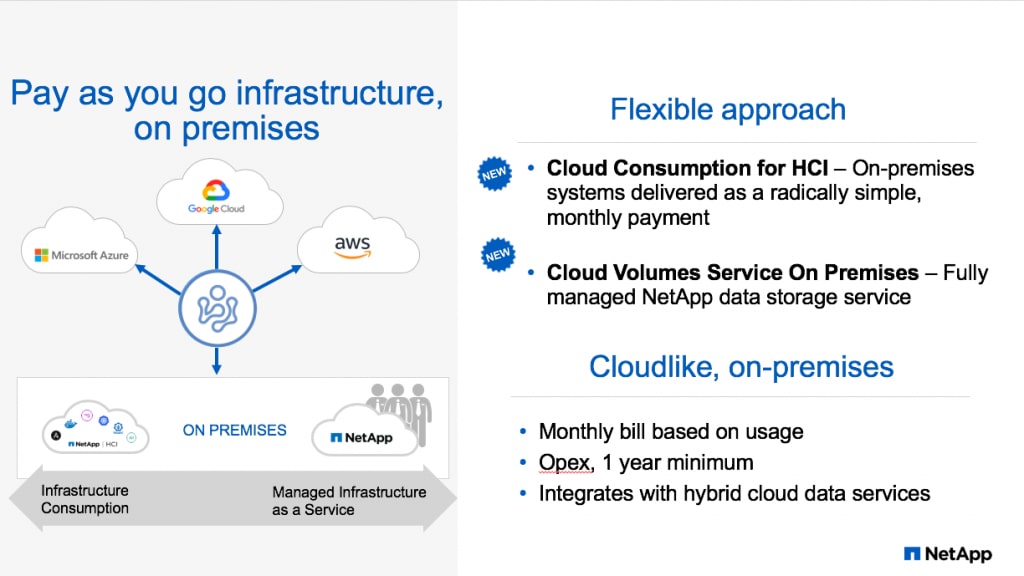Simplify Data Management Across Public or Private Clouds with NetApp Cloud Volumes


Jason Blosil
The benefits of moving to the cloud are well understood, and most companies are quickly moving to adopt a cloud strategy. But the challenges associated with moving applications and data to the cloud may delay plans. Most companies face the decision of whether to build new applications in the cloud, rearchitect existing applications, lift applications with limited or no modification, or not move them at all. Until recently, these decisions were more difficult because adequate cloud storage options were limited. NetApp has changed the game by offering the most feature-rich portfolio of cloud data service offerings across your data fabric.

To help organizations build new or migrate existing applications to the cloud, NetApp offers both native storage services and data management appliances. Both are now available on all three of the largest cloud providers, Microsoft Azure, AWS, and Google Cloud. We have also extended the simplicity and benefits of our cloud native offerings on the premises with easy consumption offerings. I’ll describe a few of the benefits of each offering, including what’s new. Let’s first look at the NetApp® public cloud offerings.
Azure NetApp Files. Azure NetApp Files is a first-party service of Azure, with easy-to-deploy cloud file services and blazing performance. Azure NetApp Files offers NFS and SMB file access, efficient snapshots, and your choice of three performance service levels. Built on 26 years of proven NetApp experience in developing data management technology, it’s ideal for Azure customers who are looking for easy-to-use, high-performance file services to support application development, high-performance databases, analytics, and more.
On May 28, Microsoft announced general availability of Azure NetApp Files, marking an important milestone in our partnership to deliver class-leading data services. Learn more about this announcement in the following blogs from Microsoft and NetApp.
Cloud Volumes Service. For customers who are looking for easy-to-manage, high performance persistent storage in the cloud, NetApp Cloud Volumes Service is an attractive solution for Google and AWS users. Moving applications to the cloud just got a whole lot easier, because applications that rely on persistent file storage can avoid costly refactoring. Like Azure NetApp Files, Cloud Volumes Service includes your choice of file protocols (NFS or SMB); advanced functionality, including space-efficient snapshots; high availability; rich native APIs; and your choice of performance tiers. You can create a volume up to 100TB in seconds. Cloud Volumes Service is ideal for use with Kubernetes and container environments that require persistent cloud storage.
Cloud Volumes Service for Google Cloud is fully integrated with Google Cloud and is now widely available as a beta release. Managed and consumed through the Google Cloud console, it includes a rich set of features and native Google APIs, allowing you to manage your storage environment and data services through a seamless common Google interface.
Cloud Volumes Service for AWS, available through the AWS Marketplace, became generally available earlier this year. In addition to the features mentioned earlier, an integrated Cloud Backup Service is available in beta and is planned for availability with our other cloud partners in the near future.

Cloud Volumes ONTAP. Some users may focus on simplicity when choosing their IT resources in the cloud, while others may also want increased control and functionality. For these users, NetApp offers Cloud Volumes ONTAP®, an instance of NetApp ONTAP data management software. Cloud Volumes ONTAP runs as a virtual appliance in your choice of cloud, giving you increased data management control in the cloud. Availability on Google Cloud is new in June 2019, complimenting the availability already offered with Azure and AWS.
Cloud Volumes ONTAP offers the same functionality as NetApp ONTAP on-premises storage, allowing you to efficiently manage your data while taking advantage of the flexibility and cost advantages of the cloud. Cloud Volumes ONTAP is ideal as a disaster recovery target between clouds or in hybrid cloud configurations, for production databases, as general purpose storage, and to deliver persistent storage to support application development by leveraging Trident.

Cloud Volumes ONTAP is rich in functionality, including file and block access, efficient NetApp Snapshot™ copies, thin clones, integrated block data replication, data encryption, efficient data reduction, cold data tiering, high availability, high performance caching, and more. Through an intuitive management user interface, Cloud Volumes ONTAP can be configured and managed across any cloud and even integrated with on-premises offerings with easy drag-and-drop features through a single pane of glass by using Cloud Manager.

Cloud Volumes in the data center. NetApp has an extensive history of providing solutions that help our customers manage their data on their premises. But the cloud is defining how customers want to manage and consume their IT resources. Customers are seeing what public cloud can offer but, either because of regulation or as a business strategy, they aren’t in a position to place their data in the cloud. For customers who want to deploy Cloud Volumes in their data center, NetApp offers two approaches.
NetApp HCI. Cloud Volumes is available as a licensed capability on NetApp HCI. NetApp HCI delivers a robust, scalable, easy-to-manage private cloud infrastructure—a fourth cloud for your applications and data. The latest release of NetApp HCI incorporates the capabilities of Cloud Volumes Service, so you can simply deploy file services in the same easy-to-use manner in your data center as you do in your choice of hyperscaler cloud. Cloud Volumes on HCI is managed through the NetApp orchestration toolset to give you everything you need to build and manage your data fabric. NetApp HCI is now available through NetApp channels via a new monthly consumption model, simplifying the way you pay and consume IT.

Cloud Volumes Service On-Premises. NetApp has also announced a storage-as-a-service offering, Cloud Volumes Service On-Premises, for customers who want to consume cloud volumes in their data center without having to buy or manage their data storage. Cloud Volumes Service On-Premises is owned and managed remotely by NetApp, freeing you from the cost and management overhead of capex purchases and IT management. This new offering is managed through the same orchestration toolset used, NetApp Fabric Orchestrator, with Cloud Volumes for HCI, enabling you to choose from file (NFS, SMB) and block (iSCSI) protocol access, three performance tiers, and three data protection service levels per volume. NetApp will size, deploy, and manage the right solution on your premises, based on your application and capacity requirements. You can keep your data local without the cost and hassle of managing equipment.

Summary
NetApp is redefining the expectations for deploying enterprise-class file services in the public cloud and on the premises. Regardless of your choice of cloud provider, you can now deploy best-of-breed file services or storage appliances that match the requirements of your budget, performance, and IT skills. And our new on-premises offerings give you a public cloud experience on your premises. Learn how to increase your innovation by decreasing your administration with NetApp. Create an account on NetApp Cloud Central today.
Jason Blosil
Jason is a business and marketing professional with over 20 years of product marketing, product management, and corporate finance experience. Since joining NetApp in 2008 he has been focused on SAN and NAS storage, backup and disaster recovery solutions, and cloud data services. When not in the office, you can find him cycling, cooking, enjoying time with family, and volunteering at his church and in the community.